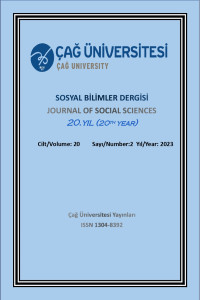Acquisition of the Word Order among Toddlers: Reflections from Turkish, Sesotho, Japanese, and Polish
Öz
Word order has been an interesting topic since systematic studies on language acquisition and the existence of linguistic principles in even radically different languages show the presence of innate constraints. Children are sensitive to the word order phenomena, and they correctly fix the value of the parameter by discovering the regularities of the language at a very early phase. Current studies mostly deal with strict word order languages like English and French. This study is intended to observe whether this basic order can be observed in languages with free word order among toddlers between 2:0 and 3:0 years old. Speech transcripts from Turkish, Sesotho, Japanese and Polish in the CHILDES database were examined, and findings show that toddlers speaking free word-order languages can make sentences with different word orders at those ages. The correct acquisition of word order in various languages that have radically different word order indicates that toddlers have an innate ability to overcome quite different syntactic properties of any language.
Anahtar Kelimeler
Language acquisition word order child language syntactic CHILDES
Kaynakça
- Akhtar, N. (1999). Acquiring basic word order: Evidence for data-driven learning of syntactic structure. Journal of Child Language, 26, 339–356.
- Aksu-Koç, A, &Slobin D. (1985). “The acquisition of Turkish.” The crosslinguistic study of language acquisition. D. I. Slobin (Ed). Hillsdale Erlbaum, New Jersey.
- Ambridge, B., & Lieven, E. (2011). Child language acquisition: Contrasting theoretical approaches. Cambridge University Press, Cambridge.
- Benavides-Varela, S., &Gervain, J. (2017). Learning word order at birth: A NIRS study. Developmental Cognitive Neuroscience, 25, 198–208.
- Bloom, L. (1970) Language Development: Form and Function in Emerging Grammars. MIT Press, Cambridge, MA.
- Brown, R. (1973) A First Language: The Early Stages. Harvard University Press, Cambridge, MA.
- Candan, A., Küntay, A., Yeh, Y. C., Cheung, H., Wagner, L., &Naigles, L. (2012). Language and age effects in children’s processing of word order. Cognitive Development, 27, 205–221.
- Chan, A., Lieven, E., &Tomasello, M. (2009). Children’s understanding of the agent-patient relations in the transitive construction: Cross-linguistic comparisons between Cantonese, German, and English. Cognitive Linguistics, 20(2), 267–300.
- Chomsky, N. (1951). A review of Skinner's verbal behaviour. Language, 35, 26-58
- Chomsky, N. (1981). Lectures on government and binding. Dordrecht: Foris.
- Christophe, A., Nespor, M., Guasti, M. T., & Van Ooyen, B. (2003). Prosodic structure and syntactic acquisition: the case of the head-direction parameter. Developmental Science, 6(2), 211–220.
- Demuth, K. (l984). Aspects of Sesotho acquisition. Bloomington: Indiana University Linguistics Club.
- Eren, Ö. (2015). Children’s acquisition of the phoneme /r/ in Gaziantep province. Journal of Child Language Acquisition and Development, 3(4), 177-183.
- Franck, J., Millotte, S., Posada, A., &Rizzi, L. (2013). Abstract knowledge of word order by 19 months: An eye-tracking study. Applied Psycholinguistics, 34, 323–336.
- Gavarró, A., Leela, M., Rizzi, L., & Franck, J. (2015). Knowledge of the OV parameter setting at 19 months: Evidence from Hindi-Urdu. Lingua, 154, 27–34.
- Guasti, Maria Teresa. (2002). Language acquisition: The growth of grammar. MIT Press, Cambridge, MA.
- Hickey, T. (1990). The acquisition of Irish: A study of word order development. Journal of Child Language, 17(1), 17-41. doi:10.1017/S0305000900013088
- MacWhinney, B. (2000). The CHILDES Project: Tools for Analyzing Talk, Lawrence Erlbaum, Mahwah, NJ.
- MacWhinney, B. (2000). The CHILDES project: The Database Vol. 2. Psychology Press, Hove.
- MacWhinney, B. (2014). The CHILDES project: Tools for analyzing talk, volume ii: The database. Psychology Press, Hove.
- Matthews, D., Lieven, E., Theakston, A., &Tomasello, M. (2005). The role of frequency in the acquisition of English word order. Cognitive Development, 20, 121–136.
- Nespor, M., Guasti, M. T., & Christophe, A. (1996). Selecting word order: The rhythmic activation principle. In U. Kleinhenz (Ed.), Interfaces in phonology (pp. 1–26). Berlin: Akademie Verlag.
- Radford, A. (1990). Syntactic theory and the acquisition of English syntax: the nature of early child grammar of English. Blackwell, Oxford.
- Slobin, D., & Bever, T. (1982). Children use canonical sentence schemas: A Cross-linguistic study of word order and inflections. Cognition, 12, 229-265.
- Sugisaki, K. (2005) Early Acquisition of Basic Word Order: New Evidence from Japanese, in A. Brugos, M. R. Clark-Cotton and S. Ha, eds., Proceedings of the 29th Annual Boston University Conference on Language Development, Cascadilla Press, Somerville, MA.
- Sussex, R., & Cubberley, P. (2006). The Slavic Languages. Cambridge University Press. Cambridge.
- Tomasello, M. (2003). Constructing a language: A usage-based theory of language acquisition. Harvard University Press, Cambridge, MA.
- Weist, R. (1983). The word order myth. Journal of Child Language, 10(1), 97-106. doi:10.1017/S030500090000516X
- Wexler, K. (1998). Very Early Parameter Setting and the Unique Checking Constraint: A New Explanation of the Optional Infinitive Stage. Lingua, 106, 23-79.
- Zhu, J., Franck, J., Rizzi, L., Gavarró, A. (2022). Do infants have abstract grammatical knowledge of word order at 17 months? Evidence from Mandarin Chinese. Journal of Child Language, 49, 60–79.
Ayrıntılar
| Birincil Dil | Türkçe |
|---|---|
| Konular | Karşılaştırmalı Dil Çalışmaları |
| Bölüm | Araştırma Makalesi |
| Yazarlar | |
| Erken Görünüm Tarihi | 29 Aralık 2023 |
| Yayımlanma Tarihi | 1 Ocak 2024 |
| Yayımlandığı Sayı | Yıl 2023 Cilt: 20 Sayı: 2 |


